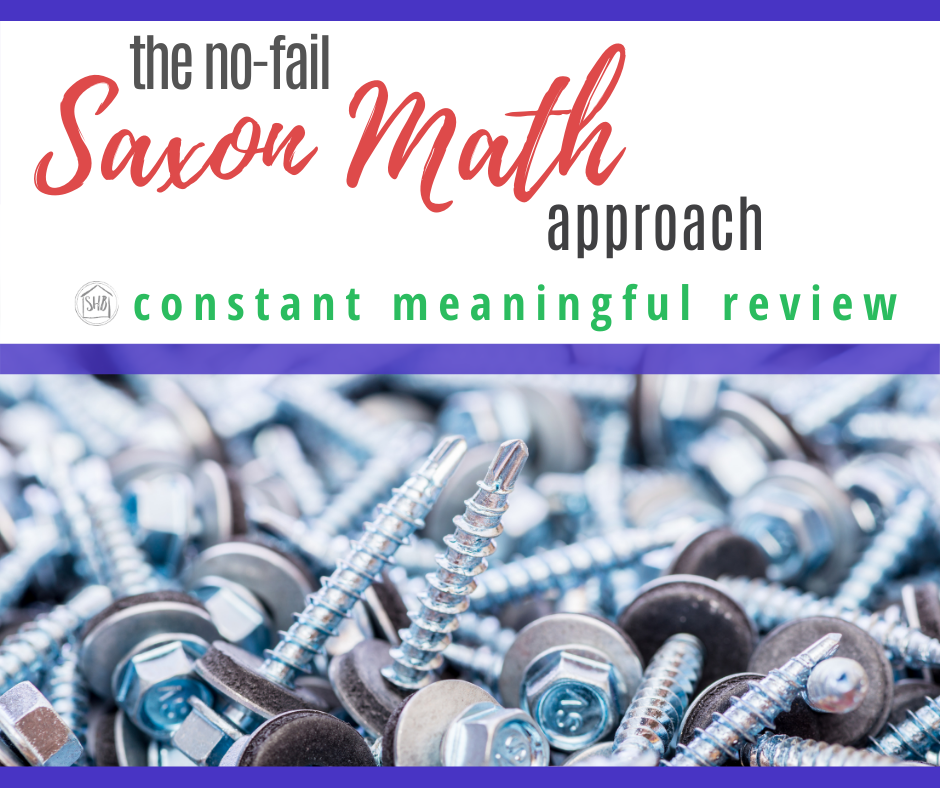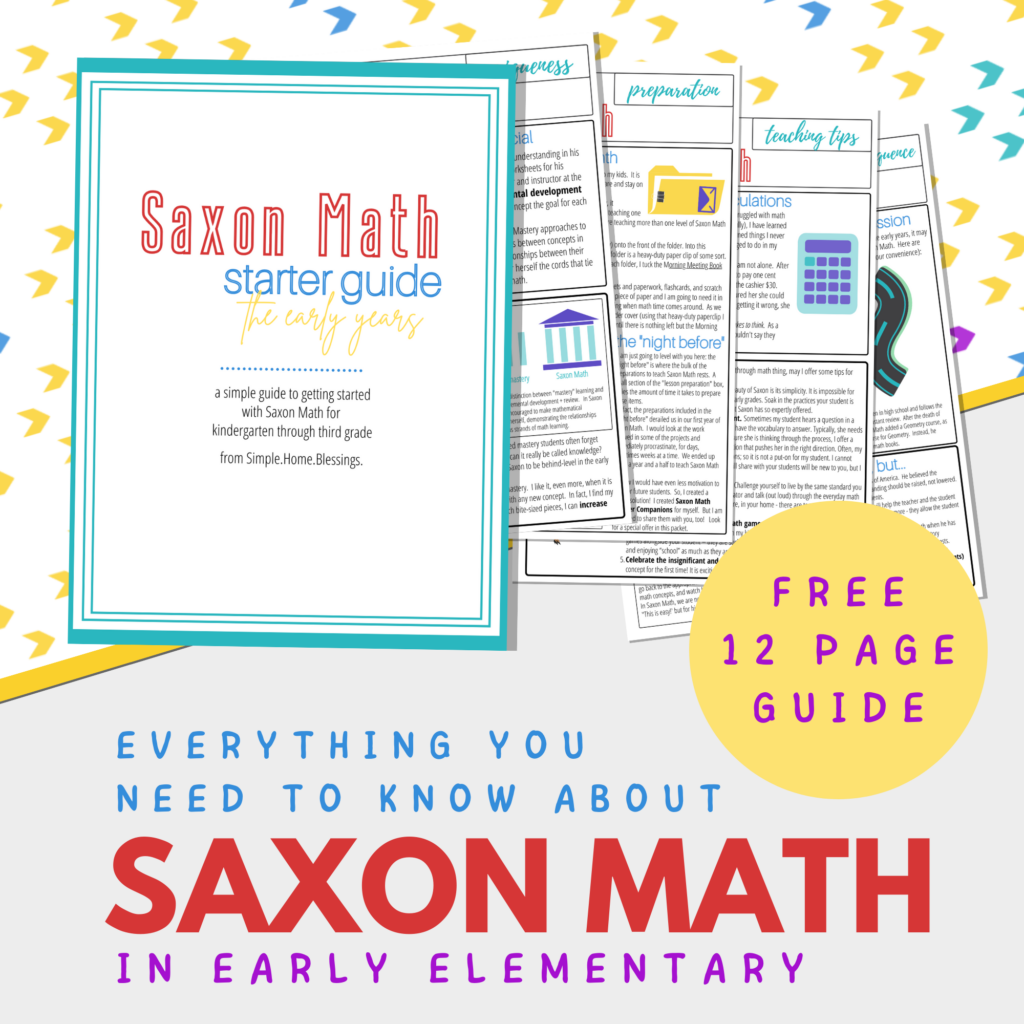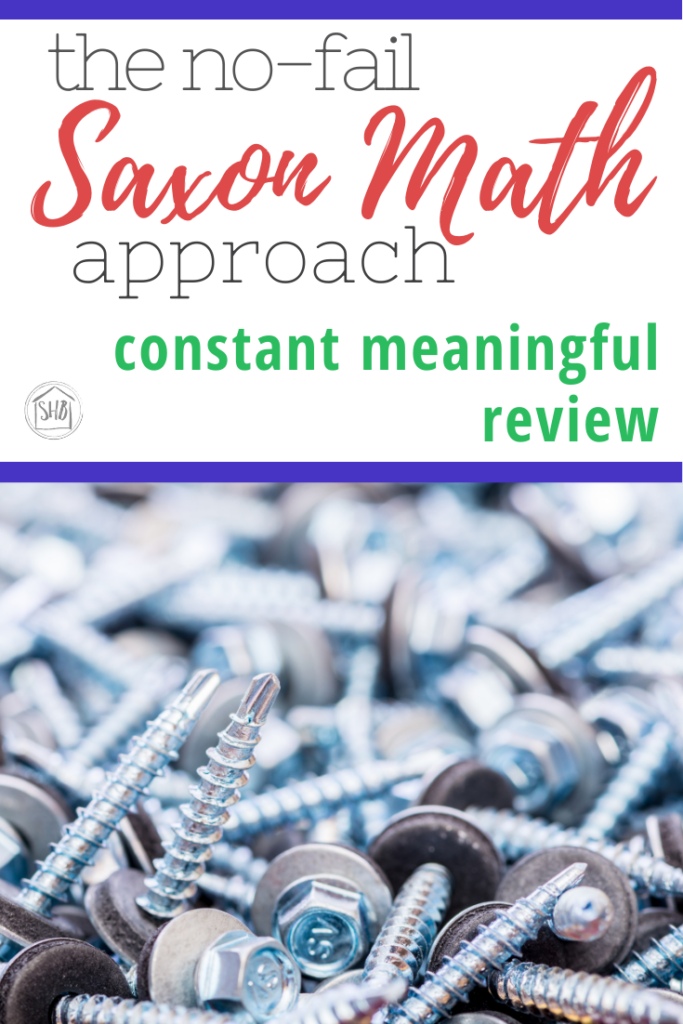
I wrote a post a couple of weeks back which grew so long that I had to cut off half of it and attach it to this post. In that post, I talked about the Saxon Math pillars of Incremental Development and Constant Meaningful Review. These two supports of the Saxon Math curriculum are what make Saxon Math so special. They must be tied together in order for the curriculum to work.
And as I said in that previous post, if you are not combining those two pillar concepts, you are doing Saxon Math incorrectly!
The results of neglecting either incremental development or constant meaningful review can often only be detected down the road a bit. But there will be effects.
Hours to complete a math lesson in the upper levels.
Frustration from a student who has to struggle with math lessons on a daily basis.
Tears and tantrums (teenage style).
Outright refusal to do a task that takes less than five minutes.
We see our kids struggle with math. And the parent’s natural response is: “All this review is frustrating. Do less.”
This post may include affiliate links. If you click and make a purchase based on my recommendation, I get a small remuneration at no extra expense to you. I only recommend things I use and believe to be a blessing.
I contend neglecting either of these pillars does your student a disservice. The beauty of Saxon’s approach is how seamlessly the review and new material are married to present math simply to your student. And I also contend Saxon Math is not a make-work curriculum. It is very lean in its design – giving a well-balanced math lesson each day for your student at every level. It should never take hours to do math with Saxon. In fact, the idea of it taking hours to complete a single lesson (especially in the early years) can be an indication that something is out of sorts. More on that later.
Constant Meaningful Review
In my last post, I defined Incremental Development. It only makes sense I would define Constant Meaningful Review as well. So what does Constant Meaningful Review mean? I got the term from Saxon himself. There is a fascinating YouTube video of a circa 1980s radio interview where he discusses much of the philosophy behind his curriculum. In that interview, he mentions Constant Meaningful Review a number of times.
As the term would imply, review is always a part of every single Saxon Math session. There are not only timed math facts sheets in every lesson from Saxon 1 on. Each lesson’s worksheets or problem sets include only a small portion of problems with new material (from the Incremental Development side of the curriculum). In the early years, it is about 10% new material and 90% review of some sort. This means in Saxon 1-3 there are only 2 questions covering the new material. The rest is review!
As for the “meaningful” part of the term, there are a few specific things I want to share with you.
Spiral Review
Saxon Math will do what people refer to as “spiral” through the material. This basically means the student will encounter the same concept a number of times throughout his math career. He will do a concept at the most basic level in 1 and then come back around to it with new understanding gained in 2 and then again in 3.

The student will always be learning math as a whole each year. He will see it a little deeper and deeper as each year passes. You can imagine it like a screw driven into a wooden board. First, the surface is breached. Then, with each turn of the screwdriver, the screw goes deeper into the board. The design of the screw is such that it will grab onto more and more of the board until it is securely in place. It takes a lot of turns to get burrowed in deep and secure. Similarly, Saxon Math’s Constant Meaningful Review will begin at the most basic level of a concept, and then add understanding with each cycle back through to the topic.
When Review turns Revelation
All this constant cyclical review is not without a purpose. The sort of “hidden gem” of the Saxon curriculum is the reasoning skills it teaches. Saxon encourages the student to make his own observations along the way. It is an important part of the curriculum. But I am not sure a lot of people see the beauty in it.
Your 1st-grade student will notice something, but then in 2nd grade notice something completely different. Even I have noticed things about math at 40 that I would have never known without Saxon asking one simple question: “What do you notice?”
John Saxon believed long-term meaningful review is one of the best things we can do for our kids. He said the practice of doing the same types of problems helps concepts sink in over time. We think we know something and by doing it enough times we start to see something even deeper.
He told a story about teaching a higher-level math concept in class one day (after many years of teaching it) and about halfway through, he (math teacher and engineer) had a lightbulb moment and realized, “It’s true!” He said he spoke those words right out loud.
If he was still making realizations after knowing, practicing, and teaching math for years, our kids can too. All that to say, the kids hit a new gear after a while (the speed increases or the accuracy, or both), and it is super exciting to watch. You don’t get that unless you do the work. And, with Saxon, the work includes review.
A Review Testimony
I used to teach Bible studies (in my pre-four-kids days) and one of the clearest memories I have is of my mother-in-law (my Bible-teaching mentor) saying this: “Review cements truth.” She was RIGHT! She knew what all good teachers know – that there is no way to review too much. The rock-solid foundation of knowledge is only built by constant meaningful review.
I always started my Bible classes with the same four questions. The first one was the easiest: “What book are we studying?” The smiles on the faces of my adult students when they knew that first answer every time was inescapable. I would then ask the next three questions which they would most likely know if they had been in class before or if they had done their homework. There were a number of reasons for this rote line of questioning. First, I wanted to start with what they knew, giving a small amount of review, building confidence, opening a dialogue. But more importantly, I wanted to give the students the context we so desperately need when studying a topic.
Saxon Math agrees with this approach when it comes to review. It believes review cements truth and builds confidence within the whole framework of mathematics.
What Happens when we Neglect Review
Earlier I mentioned the tendency of parents to simply advise their students to move on, to do less review. Some parents/teachers even encourage their students to do either odds or evens on each lesson. Some students complain about the math fact practice sheets being timed, so parents relent and allow them to do it at their own pace.
Automaticity
This neglect of the review process is detrimental to students in later levels because they lack automaticity. This concept of automaticity is discussed in Using John Saxon’s Math Books by Art Reed
Mastery occurs through a process referred to as automaticity. When John Saxon took his first manuscript to the University of Chicago he asked Dr. Benjamin Bloom (of Bloom’s Taxonomy) to look at his book’s methodology. Dr. Bloom informed John that he had not created a new teaching method. He himself had come up with the concept in the early 1930’s.
Dr. Bloom referred to this method as automaticity. He described this as the ability of the human mind to accomplish two things simultaneously so long as one of them was over-learned (or mastered). He told John that the two critical components of this phenomenon were repetition and time…
Automaticity is another way to describe the placing of information or data into our long term memory. The process requires that the two components of repetition and of time, be used simultaneously.
This automaticity is what we want our high school students to have when they reach the upper levels of math. It has been compared to the real-world experience of learning to drive. When I first learned to drive, it took all my brainpower just to operate the vehicle in an empty parking lot. After years and years of driving, I can now operate the vehicle safely while listening to music, stopping to answer the phone (hands-free), telling my kids to sit in their seats, and thinking about what we will eat for dinner.
Why we Need Constant Meaningful Review
By the time our students get to algebra and beyond, we want them to struggle only with the new concepts of formulas and equations. The operations inside those equations and the laws that govern them should be long-mastered concepts by then. Thus they can focus on the difficult matters of higher-level math. What’s more, they will be able to do it QUICKLY!
I am completely convinced that the reason for tears in a math class is exhaustion. The child who has to struggle to remember basic math operations over and over (and over) while also trying to apply those operations to a specific formula is tired of thinking. She ought to be tired! It is hard for the unpracticed and the novice. Add to this that some of those math facts practice sheets are going to be timed – I would cry too!
What we are doing when we neglect Constant Meaningful Review is leaving our students novices. We teach them the Incremental Development side of the curriculum, but we forgo the more necessary review they need to develop from novice to master. The practice of Constant Meaningful Review develops mastery which leads to automaticity. It produces students who are confident and unintimidated by math. This alone is worth its weight in gold – I would have loved to have a small measure of math confidence when I was a young student.
By the way, I have a LOT to say about Saxon Math. I took the time to put together a 12 page primer for Saxon Math in the Early Years. You can get your copy of it when you sign up right here:

Interested in more about Saxon Math? I hope these articles are a blessing to you:














